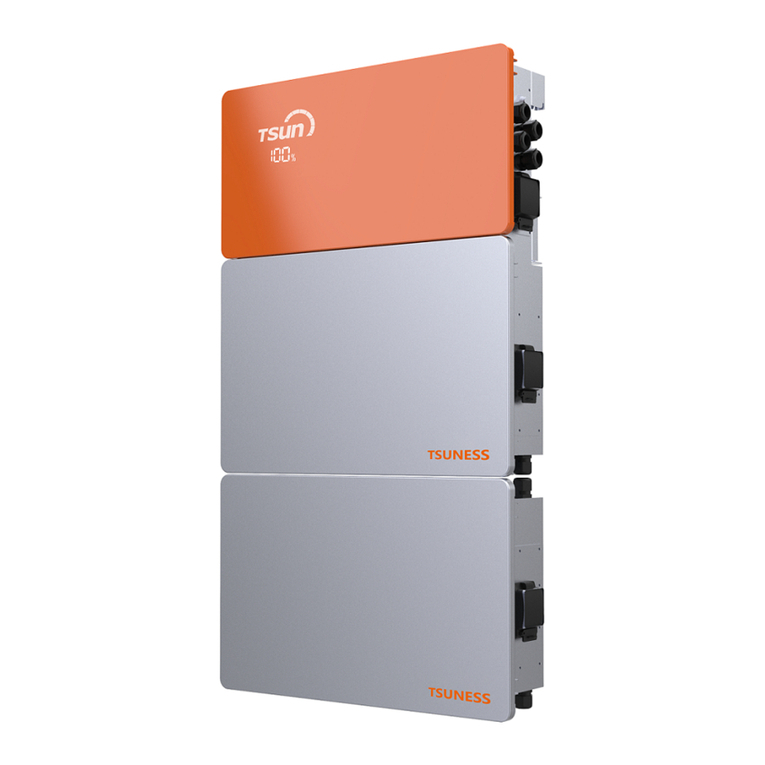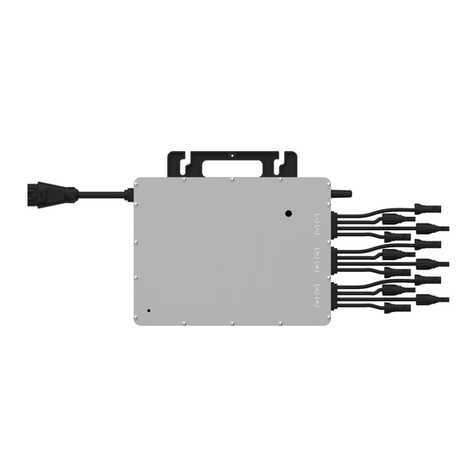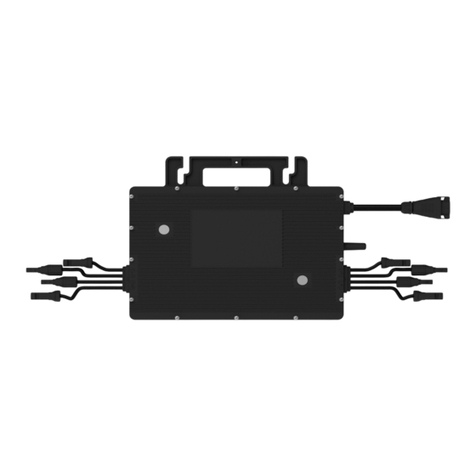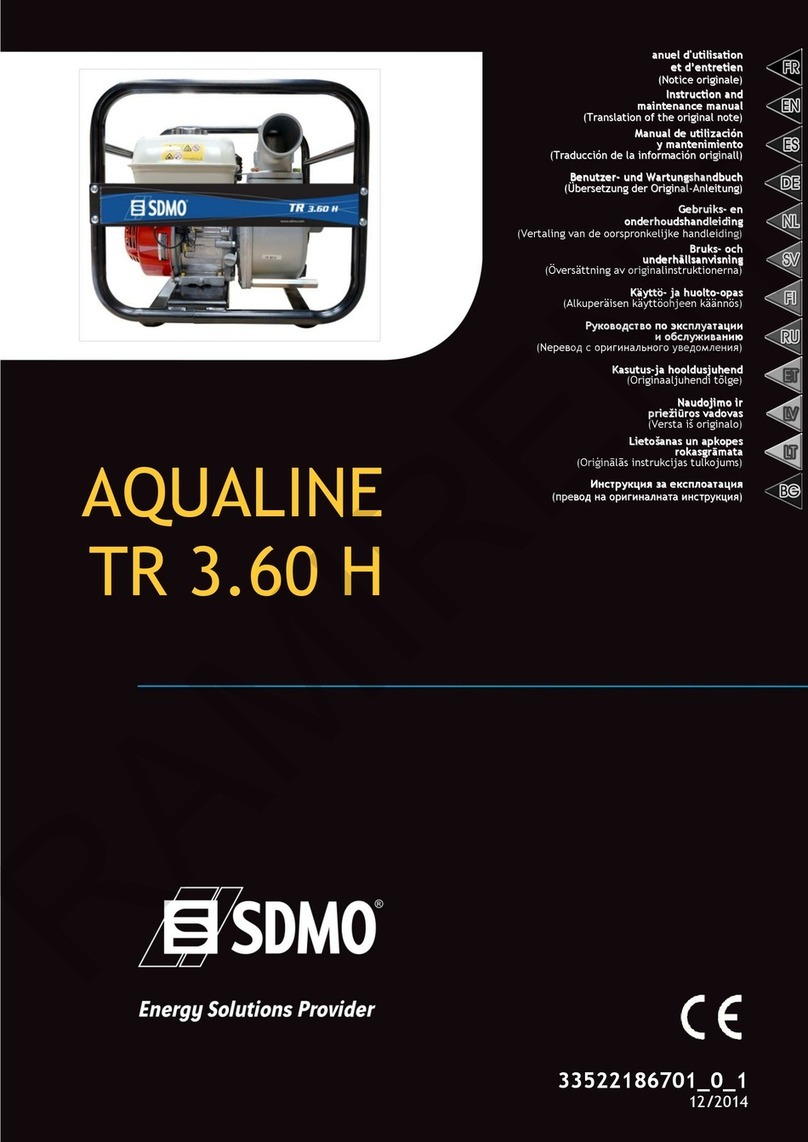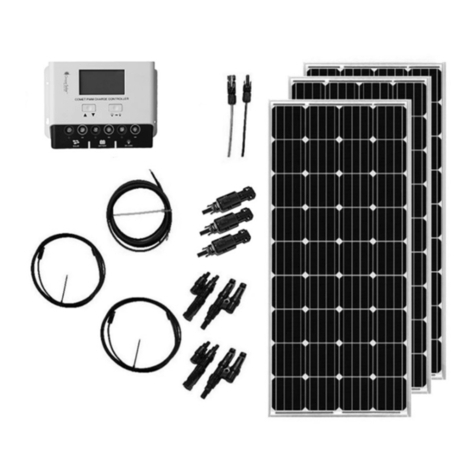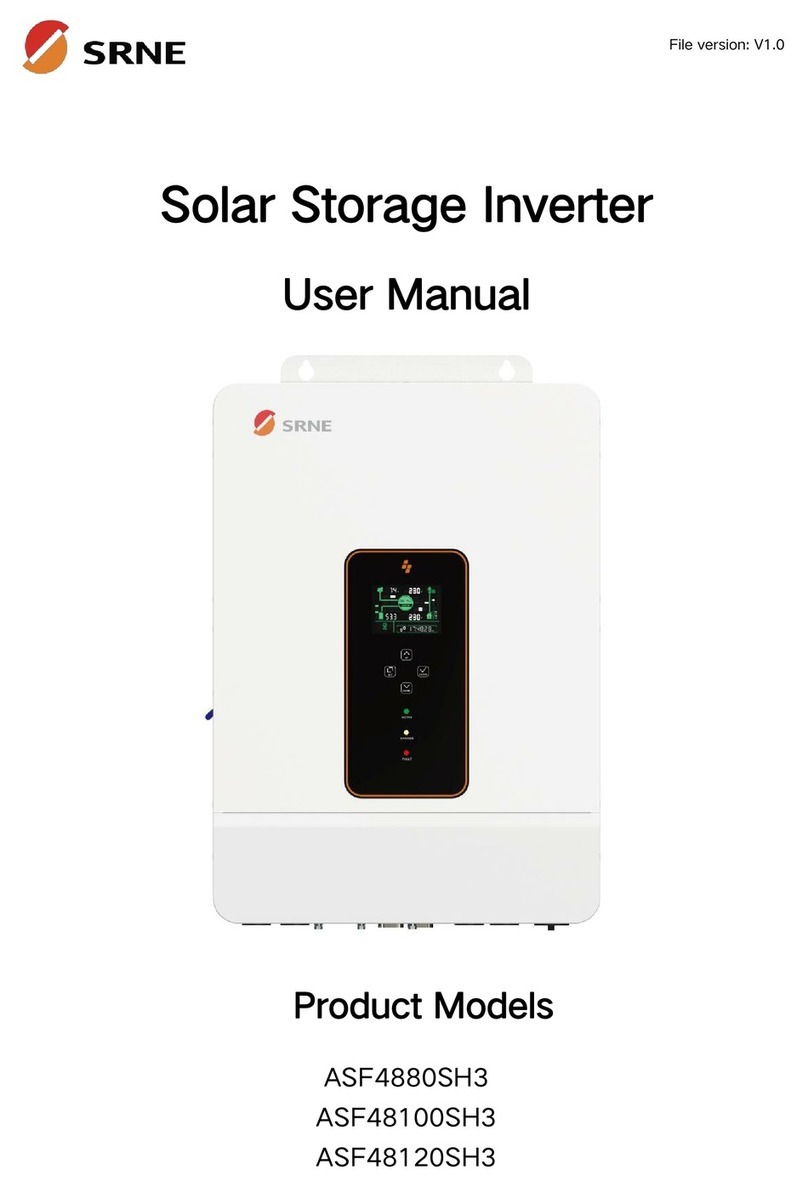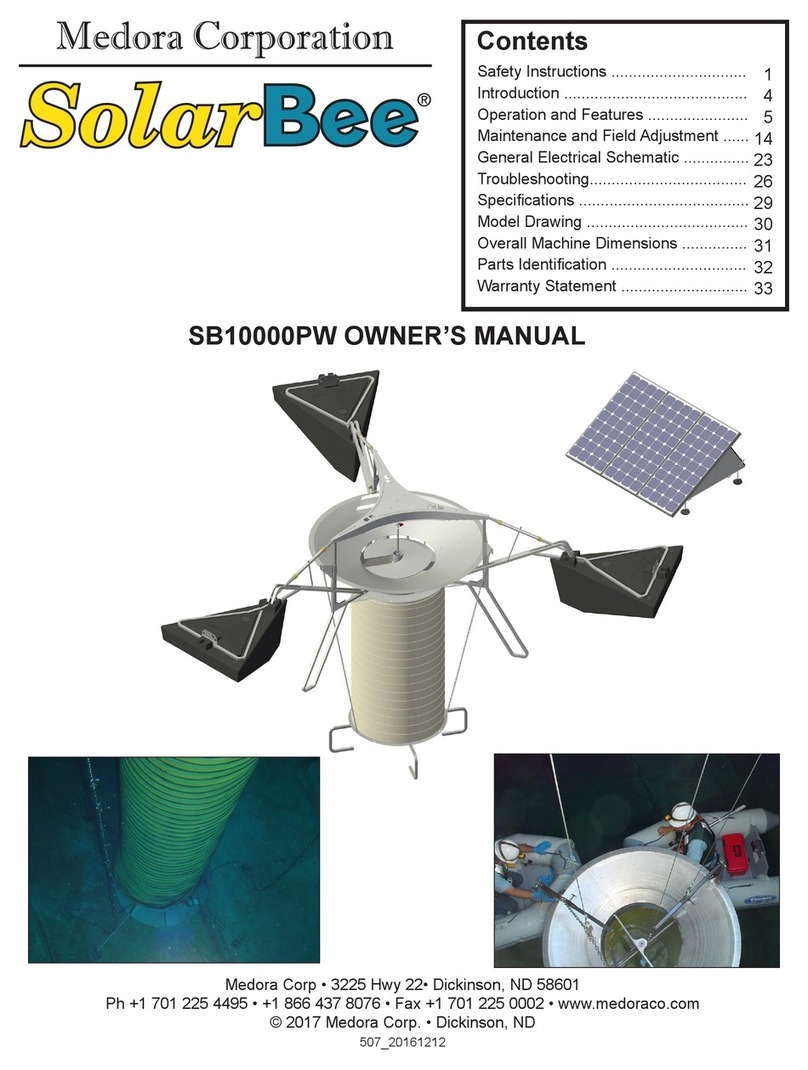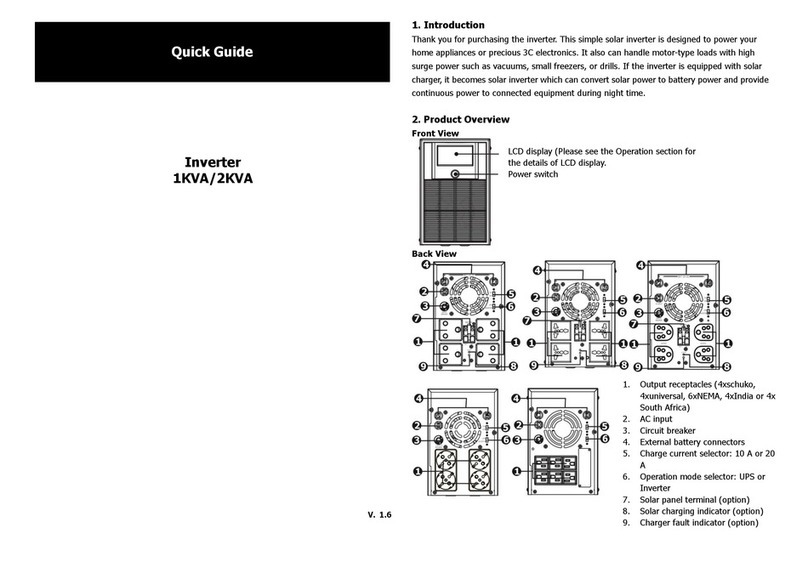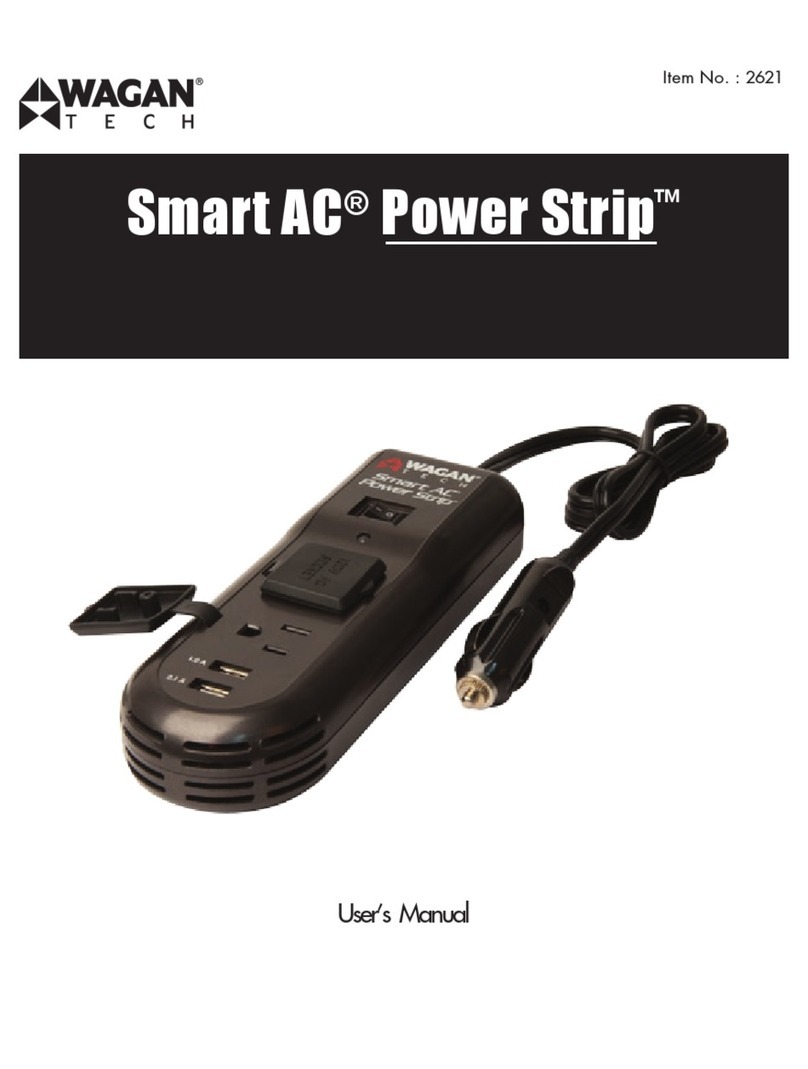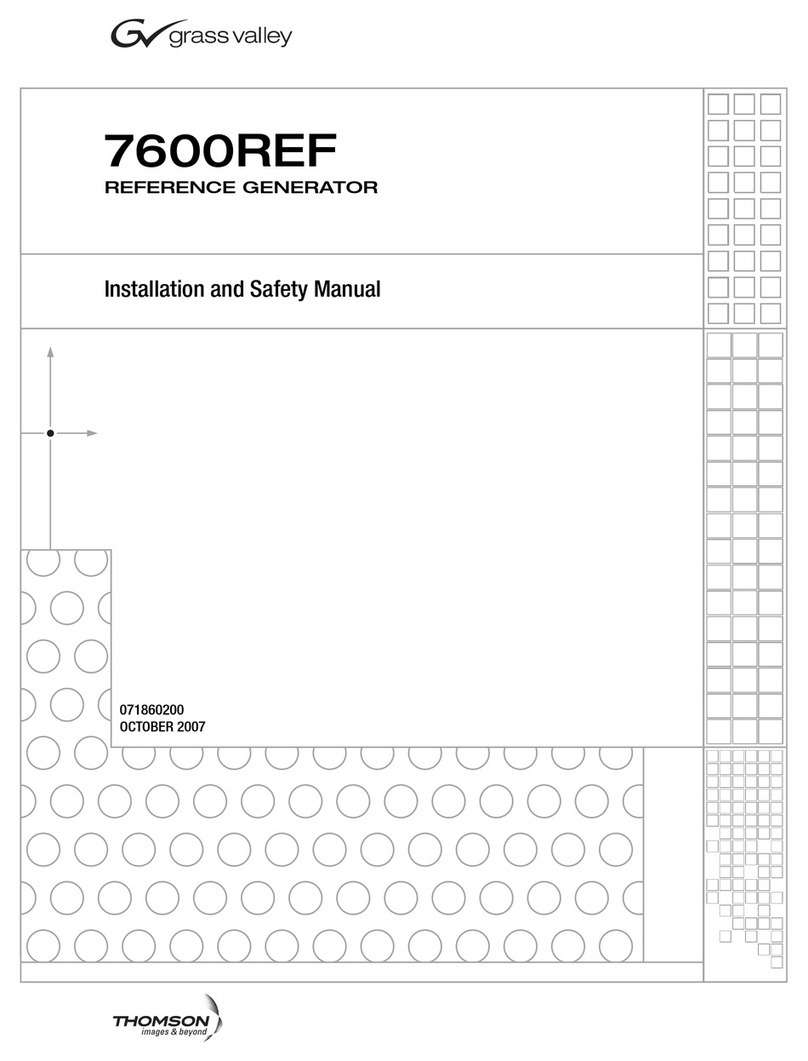Thermo King 1100 User manual

1
Printed in U.S.A.
TK 55872-19-OP (Rev. 0, 01/14)

2
Welcome
Please read this manual thoroughly before installing and operating your
new Thermo King®Power Inverter. This manual contains information
you need to obtain the performance required for your application. Keep
this manual for future reference.
This Thermo King Power Inverter converts low voltage, direct current
(DC) to 110 volt modified sine wave (MSW) alternating current (AC). The
inverter draws power from 12 volt batteries such as those used on
commercial trucks and from other high current 12 volt sources.
This model, 1100 / 1500 / 2000, has been performance tested by MET
and complies with Underwriter’s Laboratories and Canadian Standards
Association safety standards.
A Higher Wattage Inverter May Be Required
To determine whether the Thermo King 1100 / 1500 / 2000 will operate a
particular appliance or a combination of appliances, run a test. All
inverters are designed to automatically shut down in the event of a power
overload. This protection feature prevents damage to the unit while
testing appliances with combined wattages in the 1100 / 1500 / 2000
watt range. Turn on the highest wattage appliance first then add other
appliances. If an appliance combination in the 1100 / 1500 / 2000 watt
range will not operate properly, then it is likely that this Thermo King
inverter does not have the required capacity to operate the appliance in
question.
WARNINGS, CAUTIONS AND NOTES
It is very important that any operator and installer of this inverter read
and follow all WARNINGS, CAUTIONS AND NOTES and all installation
and operation instructions. In particular, comply with WARNINGS
(possibility of serious injury or death), CAUTIONS (possibility of damage
to the inverter and / or other equipment), and NOTES (included to assist
you in achieving the maximum performance and longest working life from
this advanced-design inverter).

3
WARNINGS: INVERTER OUTPUT
This is a heavy-duty device that produces voltages similar to commercial
AC power.
Danger of shock or electrocution - treat inverter output the same as
commercial AC power.
Do not use the inverter near flammable materials or in any locations
that may accumulate flammable fumes or gases. This is an electrical
device that can briefly spark when electrical connections are made or
broken.
Do not allow water or other liquids to contact the inverter.
Do not use appliances with damaged or wet cords.
CAUTIONS: INVERTER OPERATING ENVIRONMENT
Surrounding air temperature should be between 4°F and 104°F
(-20°C and 40°C) – ideally between 60°F and 80°F (15°C and 25°C).
Keep the inverter away from direct sunlight if at all possible.
Keep the area surrounding the inverter clear to ensure free air
circulation around the unit. Do not place items on or over the inverter
during operation. The unit will shut down if the internal temperature
gets too hot. Restart the inverter after it cools.
This Thermo King Power Inverter will only operate from a 12 Volt DC
power source. Do not attempt to connect the inverter to any other
power source, including any AC power source.
Do not reverse DC input polarity – this may damage the inverter and
will void the warranty.
APPLIANCE CAUTIONS
Do NOT plug in battery chargers for cordless power tools if the
charger carries a warning that dangerous voltages are present at the
battery terminals.
Certain chargers for small nickel-cadmium or nickel-metal-hydride
batteries can be damaged if powered by this inverter. Two types of
appliances are susceptible to damage:
oSmall, battery-operated appliances such as flashlights.
oCordless razors and toothbrushes that plug directly into
an AC receptacle.
Do NOT use this inverter with the above two types of equipment.
The majority of portable appliances do not have this problem. Most

4
portable appliances use separate transformers or chargers that plug
into AC receptacles to supply a low-voltage DC or AC output to the
appliance. If the appliance label states that the charger or adapter
produces a low-voltage DC or AC output (30 volts or less), there will
be no problem powering that charger or adapter.
Some fans with synchronous motors may slightly increase in speed
(RPM) when powered by the inverter. This is not harmful to the fan
or to the inverter.
Route appliance cords and extension cords to prevent accidental
pinching, crushing, abrading and tripping people.
Use safety approved extension cords rated at 15 amps or higher.
GFCI devices may not work with modified sine wave (MSW) power.
This inverter is not tested for use with medical equipment.
This inverter is not tested for use in marine applications.
In the event of a continuous audible alarm or automatic shut down,
turn the inverter OFF immediately. Do not restart the inverter until the
source of the problem has been identified and corrected.
When attempting to power lead acid battery chargers, with modified
sine wave, monitor the temperature of the battery charger for
approximately 10 minutes. If the battery charger becomes
abnormally warm, immediately disconnect it from the inverter.
Getting Started
When a motorized appliance or a tool turns on, there is an initial surge of
power to start. This surge of power is referred to as the "starting load" or
"peak load." Once started, the tool or appliance requires less power to
operate. This is referred to as the "continuous load" in terms of power
requirements. You will need to determine how much power your tool or
appliance requires to start up (starting load) and it's continued running
power requirements (continuous load).
Power consumption is rated in watts, or it can be calculated from
amperes (amps). This information is usually stamped or printed on most
appliances and equipment. If this information is not indicated on the
appliance or equipment, check the owner's manual. For electrically
sensitive equipment, contact the manufacturer to determine if the device
you are using is compatible with modified sine wave AC.

5
Multiply: AC AMPS X110 (AC voltage) = WATTS
This formula yields a close approximation of the continuous load of your
appliance.
Multiply: WATTS X2= Starting Load for most appliances
This formula yields a close approximation of the starting load of most
appliances. Exceptions are motorized appliances such as pumps,
freezers and air conditioners. These appliances can have startup loads
of up to eight times the rated watts.
Front Panel 1100 / 1500 / 2000
A. LCD Digital Display (See LCD Diagram on Page 6).
B. ON / OFF Switch. Turns the inverter circuits ON and OFF.
C. Display Selector Switch.
D. Two standard North American AC outlets, each rated at 15 Amps
(1650 Watts).
E. Two USB Ports (2.1 Amp Shared).

6
LCD Diagram
1. Battery Level.
2. Output wattage (W) or input voltage display (VDC).
3. Warning indicator –
a. High voltage
b. Low voltage
c. Voltage overload.
4. Temperature shutdown.
Rear Panel 1100 / 1500 / 2000
F. High-Speed Cooling Fan. When the temperature inside the inverter
exceeds a preset limit, the Cooling Fan automatically turns on to cool
the inverter. When the temperature reduces, the fan turns off.
G. Negative Power Input Terminal.
H. Positive Power Input Terminal.
I. Remote Control Receptacle.
J. Ground Terminal.
K. Main Switch.

7
Determining the DC Power Requirements
Powering multiple appliances from the high-power 1100 / 1500 / 2000
inverter requires a 12 volt bank of batteries (several batteries). To
calculate the approximate power in amps a 12 volt battery bank has to
supply you need to know the current, or amps required for powering the
continuous AC load.
A shortcut method is to divide the continuous AC load wattage by 10. For
example, the continuous AC load is 1500 watts. The current (amps) is:
1500/10 or 150 amps at 12 Volts DC. Add to the load any DC
appliances that may be powered by the battery bank.
Sizing the Battery Bank
To determine the minimum battery bank ampere-hour rating that
you will need to operate appliances from the inverter, and any DC
appliances powered by the battery bank, follow these steps:
1. List the maximum wattage that the inverter has to provide (as
above).
2. Estimate the number of hours the appliances will be in use
between battery recharges. This will differ depending on
appliances. As an example, a typical home-use coffeemaker
draws 500 watts during its brew time of 5 minutes; it maintains
the temperature of the pot at about 100 watts. Typical use of a
microwave oven is only for a few minutes. Some longer
operating time appliances are lamps, TV's, computers and
refrigerator / freezers.
3. Determine the total watt-hours of energy needed. Then multiply
the average power consumption in watts by the number of
hours of run time. For example: 1500 watts for 10 hours =
15,000 watt hours. Using the 1500 watts (or 150 amps) for 10
hours example as above, then 150 amps is needed for 10
hours. This provides us with the basic amp-hours (AH) of
battery that is required. Ten hours at 150 amps equals 1500
Amp Hours (AH). This answer is just a beginning because
there are other conditions that determine actual run time.

8
These include:
• AC appliance load and time in use (basic Amp Hour)
• Cable gauge and length (cable losses)
• Charge level of the batteries (between use, chargers have
to be able to fully charge the batteries)
• Temperature of the batteries (colder batteries provide fewer
amps)
• Age and condition of the batteries (older batteries lose
capacity/amp hours)
• Compliance with turning off unnecessary AC and DC loads.
If there is any doubt about sizing the battery bank, it is safe to
over estimate the amp hour requirements of the battery bank.
Note:
The type of batteries you use to power your high power inverter is
important. Operating a high-power inverter will routinely discharge
batteries and they will require frequent recharging.
Operation
1. Turn On the inverter.
2. Turn OFF the inverter.
3. When you have confirmed that the appliance to be operated is
turned off, plug an appliance cord into one of the two 110v AC
Outlets on the front panel of the inverter.
4. Turn ON the inverter.
5. Turn the appliance on.
6. Plug in additional appliances and turn them on.
Note:
The audible alarm may make a momentary "chirp" when the inverter is
turned OFF. This same alarm may also sound when the inverter is being
connected to or disconnected from the 12 volt battery bank.

9
Television and Audio Suggestions
Although all Thermo King Power Inverters are shielded and filtered to
minimize signal interference, some interference with your television
picture may be unavoidable, especially in weak signal areas.
However, here are some suggestions that may improve reception:
1. First, make sure that the television antenna produces a clear signal
under normal operating conditions. Also, ensure that the antenna
cable is properly shielded and of good quality.
2. Change the positions of the inverter, antenna cables and TV power
cord.
3. Isolate the TV, its power cord and antenna cables from the 12 volt
power source by running an extension cord from the inverter to the
television set.
4. Coil the television power cord and the input cables running from the
12 volt power source to the inverter.
5. Attach a "Ferrite Data Line Filter" to the television power cord. More
than one filter may be required. These filters are available at most
electronic supply stores.
Note:
Some inexpensive audio systems may produce a slight "buzzing" sound
when operated with the inverter. The only solution to this problem is to
use a sound system with better power supply filtering.
Operating a Microwave oven with Your Power Inverter
The power rating used with microwave ovens is the "cooking power"
which means the power being "delivered" to the food being cooked. The
actual operating power rating is listed on the back of the microwave. If
the operating power cannot be found on the back of the microwave,
check the owner's manual or contact the manufacturer.
How This Modified Sine Wave Power Inverter Works
There are two stages in which this power inverter changes the 12 volt
DC (or battery) power into 110 volt AC (household current).
STAGE 1: This inverter uses a DC to DC converter to increase the DC
input voltage from the battery to 145 volts DC.
STAGE 2: The inverter then converts the high voltage DC into 110 volt

10
AC (household current), using advanced MOSFET transistor in a full
bridge configuration. This design provides this Thermo King Power
Inverter with the capability to start and run difficult reactive loads, while
providing excellent overload capability. The waveform that is generated
by this conversion is a "modified sine wave" as shown in the diagram
below.
Best use of Battery Power
Make sure any appliances are energy efficient and turned off after use.
Use Compact Florescent Lamps. Wherever possible, charge with Solar
Panels or Wind Generators. Do not allow lead acid batteries to remain
discharged for long periods of time, they lose capacity (amp hours).
Disposal / Recycling of Inverter / California Proposition 65
Electronic products are known to contain materials that are toxic if
improperly disposed. Contact local authorities for disposal and recycling
information.
This inverter is certified to be “lead free”. Transformers in this inverter
contain nickel composites. Nickel is a known neuro-toxin if ingested.

11
Troubleshooting
PROBLEM: No Input Voltage
Reason Solution
Poor contact with battery
terminals.
Shut down inverter and
disconnect. Clean terminals
thoroughly and reconnect.
Blown DC battery fuse(s). Turn off inverter. Fix problem.
Replace fuse(s) with same type
and rating.
PROBLEM: Inverter is Shut Down
Reason Solution
Battery voltage below 10
Volts. Charge or replace battery.
Inverter is too hot (thermal
shut down mode). Will be
indicated on LCD panel.
Allow inverter to cool. Check
for adequate ventilation. Re-
duce the load on the inverter
to rated continuous power.
Unit may be defective. See warranty and call
customer service.
PROBLEM: Low Battery Alarm on all the Time
Reason Solution
Input voltage below 10.5
Volts. Will be indicated on
LCD panel.
Keep input voltage above 10.5
Volts to maintain regulation.
Poor or weak battery
condition. Recharge or replace battery.
Inadequate power being
delivered to the inverter or
excessive voltage drop.
Use lower gauge (heavier)
cable. Keep cable length as
short as possible.
PROBLEM: TV does not Work
Reason Solution
TV does not turn on. Contact TV manufacturer to
find out if the TV is compatible
with a modified sine wave.

12
Specifications: 1100
Specifications Description
Output Continuous Watts (W) 1100 W +10W(USB)
Surge Capacity (Peak Power) 2200 W
Rated Input DC (V,A) 12VDC , 118A
Input Voltage Range 10.5 to 15.5 VDC
Rated Frequency (Hz) (60Hz±1)
Rated Output AC (V,A) 12.5A(105-125)
Rates Output USB (V,A) 2 * 5V/max. 2.1A (I-Pad)
No Load Current <0.5A DC
Optimum Efficiency 90% min.
Fuse (A) (40A*3)
Fuse Type Internal Blade
Output Wave Form Modified Sine Wave
Max. Touch Temperature 65°C Max
Operating Temperature 0° to 40°C
Operating/Storage Humidity RH 5 to 95%
Cooling System Thermo Fan
THD 35%
Power Factor 0.65 Min
Ripple & Noise(Peak to Peak) <250mV
Dimensions LxWxH (inches) 11.77 x 6.71 x 3.46
Assembled Weight (LBS) 4.24 lbs.
NOTE:
All specifications are typical at nominal line, half load, and 77°F (25°C) unless
otherwise noted. Specifications are subject to change without notice.

13
Specifications: 1500
Specifications Description
Output Continuous Watts (W) 1500 W +10W(USB)
Surge Capacity (Peak Power) 3000 W
Rated Input DC (V,A) 12VDC , 161A
Input Voltage Range 10.5 to 15.5 VDC
Rated Frequency (Hz) (60Hz±1)
Rated Output AC (V,A) 120V +/- 5% , 12.5A(105-125)
Rates Output USB (V,A) 2 * 5V/max. 2.1A (I-Pad)
No Load Current <0.7A DC
Optimum Efficiency 90% min.
Fuse (A) (40A*4)
Fuse Type Internal Blade
Output Wave Form Modified Sine Wave
Max. Touch Temperature 65°C Max
Operating Temperature 0° to 40°C
Operating/Storage Humidity RH 5 to 95%
Cooling System Thermo Fan
THD 35%
Power Factor 0.65 Min
Ripple & Noise(Peak to Peak) <300mV
Dimensions LxWxH (inches) 13.84 x 6.71 x 3.46
Assembled Weight (LBS) 5.70 lbs.
NOTE:
All specifications are typical at nominal line, half load, and 77°F (25°C) unless
otherwise noted. Specifications are subject to change without notice.

14
Specifications: 2000
Specifications Description
Output Continuous Watts (W) 2000 W +10W(USB)
Surge Capacity (Peak Power) 4000 W
Rated Input DC (V,A) 12VDC , 215A
Input Voltage Range 10.5 to 15.5 VDC
Rated Frequency (Hz) (60Hz±1)
Rated Output AC (V,A) 120V +/- 5% , 16.7A(105-125)
Rates Output USB (V,A) 2 * 5V/max. 2.1A (I-Pad)
No Load Current <0.8A DC
Optimum Efficiency 90% min.
Fuse (A) (40A*6)
Fuse Type Internal Blade
Output Wave Form Modified Sine Wave
Max. Touch Temperature 65°C Max
Operating Temperature 0° to 40°C
Operating/Storage Humidity RH 5 to 95%
Cooling System Thermo Fan
THD 35%
Power Factor 0.65 Min
Ripple & Noise(Peak to Peak) <350mV
Dimensions LxWxH (inches) 15.39 x 6.71 x 3.46
Assembled Weight (LBS) 6.84 lbs.
NOTE:
All specifications are typical at nominal line, half load, and 77°F (25°C) unless
otherwise noted. Specifications are subject to change without notice.

15
Warranty Summary
Contact your local Thermo King Dealer for Warranty Coverage terms.
Warranty coverage may vary depending on how the equipment was
purchased. For components purchased independent of a Thermo King
APU, see Thermo King Aftermarket Warranty schedule, document
TK51341. For equipment purchased with and covered under the Thermo
King APU Warranty see Limited Warranty Summary Grid TK53051.
This manual suits for next models
2
Table of contents
Popular Inverter manuals by other brands
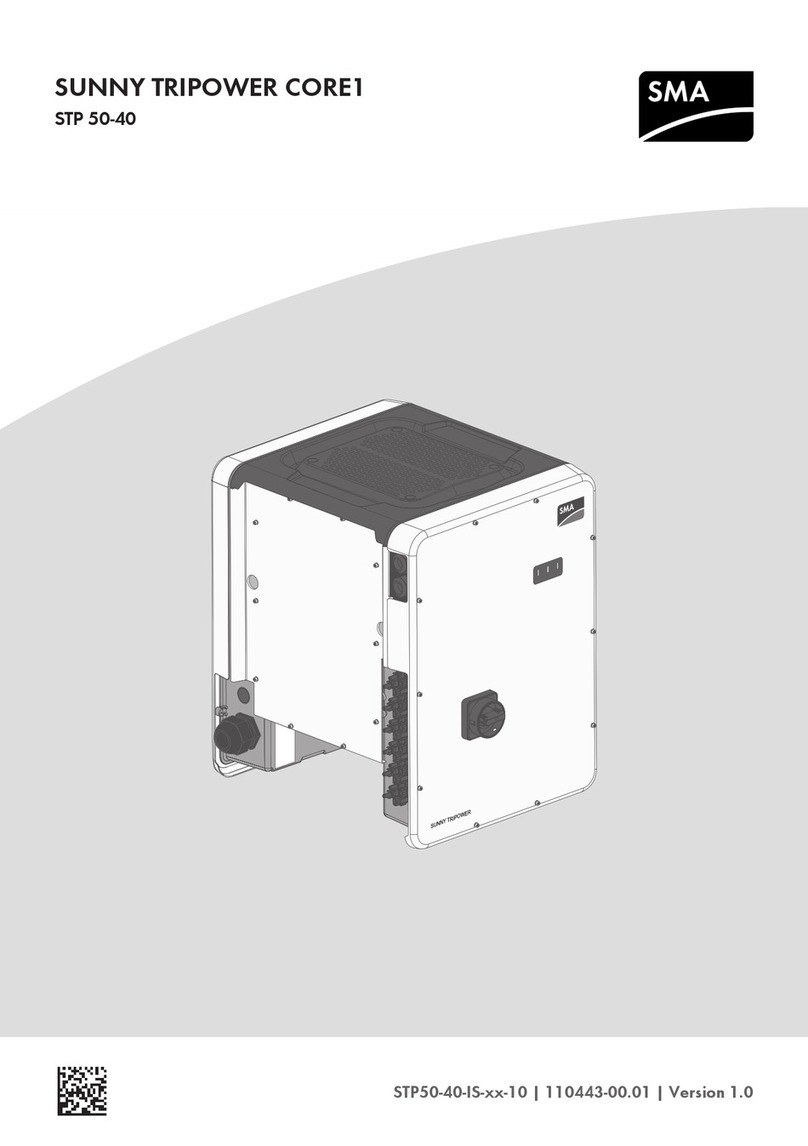
SMA
SMA SUNNY TRIPOWER CORE1STP 50-40 Quick reference guide
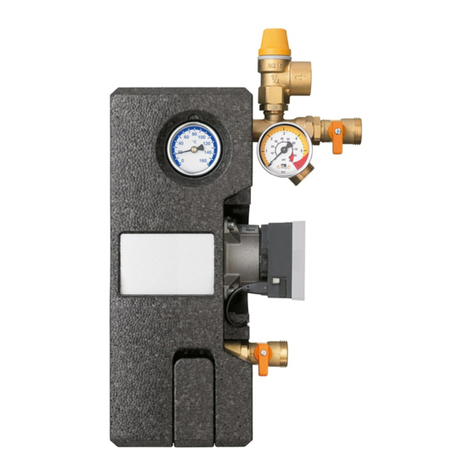
STIEBEL ELTRON
STIEBEL ELTRON SOKI BASIC Operation and installation
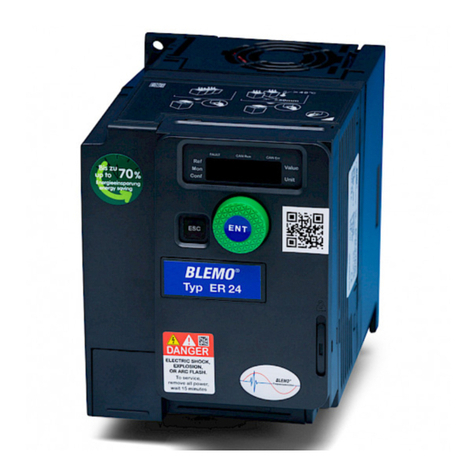
BLEMO
BLEMO ER24 Series Programming manual
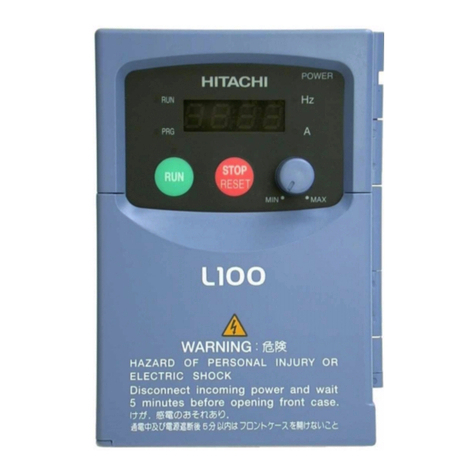
Hitachi
Hitachi L100 Series instruction manual

HP
HP 8671B Operating and service manual
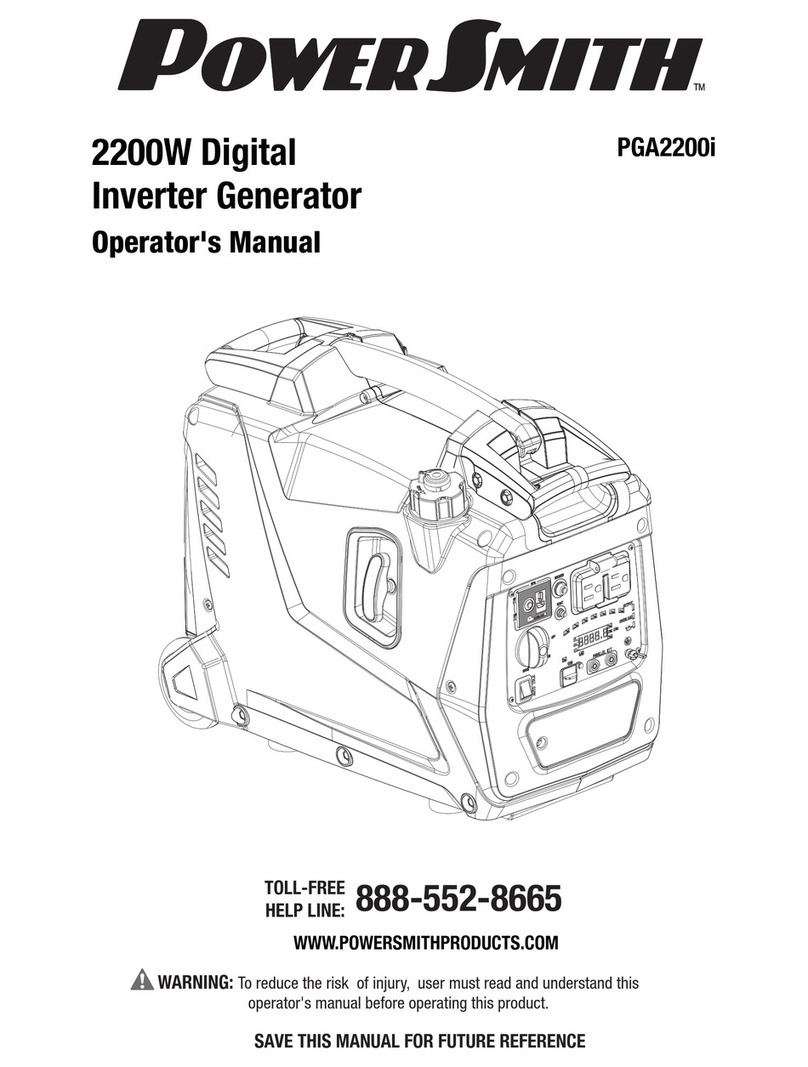
Richpower
Richpower Power Smith PGA2200i Operator's manual
